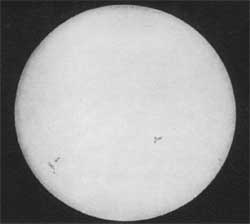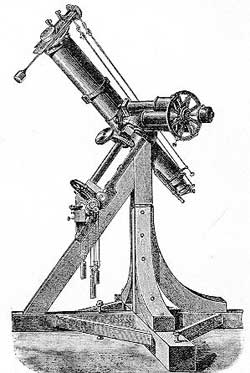
Sun-Earth Day Presents: Eclipse, In a Different Light
Some pictures are worth a thousand words...
TECHNOLOGY THROUGH TIME ISSUE #40: FIRST SUN PHOTO

Daguerrotype image of the sun made by Louis Fizeau in 1845.
The first surviving daguerrotype photograph of the sun (Figure 1) was taken at the dawn of photography in 1845 by French physicists Louis Fizeau (1819-1896) and Lion Foucault (1819-1868). The 5-inch image showed many details including a few sunspots. Berkowski later made the first solar eclipse photograph on July 28, 1851, also using the daguerrotype process, at the Royal Observatory in Königsberg, Prussia (now Kalinigrad in Russia). Berkowski, a local daguerrotypist whose first name was never published, observed at the Royal Observatory. A small 6-cm refracting telescope was attached to the 15.8-cm Fraunhofer heliometer (Figure 2) and a 84-second exposure was taken shortly after the beginning of totality.

Fraunhoffer heliometer at the Royal Observatory of Königsberg ca 1851 which was used to make first photograph of a total solar eclipse.
By 1858, daily photographic records of the solar surface were taken by Warren de la Rue (1815-1889) at the Kew Observatory in England, and by Jules Janssen (1824-1907) at the Meudon Observatory near Paris. For the next 14 years, de la Rue record the complete 11 year solar cycle in a series of almost 3000 images that clearly showed sunspots and other features. De la Rue's group also obtained photographs of the 18 July 1860 total eclipse in Spain. Photographs obtained at the same time by A. Secchi located 500 km from De la Rue, showed that prominences could not belong to the Moon, but were in fact of solar origin.
Meanwhile, eclipse photography had improved enormously thanks to the invention of the radial gradient filter. This filter made the inner, bright regions of the corona much dimmer, and let astronomers study the faint details of the corona out to several times the radius of the sun from its surface.
RELATED SITES
Technology Through Time
ISSUES
- #46: The Magnetic Sun
- #45: Coronagraph
- #44: Einstein
- #43: Coronium
- #42: The Sun - In a Different Light
- #41: Gallery of Drawings
- #40: First Sun Photo
- #39: Solar Spectroscopy
- #38: George Ellery Hale
- #37: Coronal Mass Ejections
- #36: First Corona Descriptions
- #35: First Sunspot Drawing
- #34: Ptolemy
- #33: Ancient Greece
- #32: Ancient Babylon
- #31: Galileo Galilei
Eclipse Fact
There are at least 2 solar eclipses per year somewhere on the Earth.


